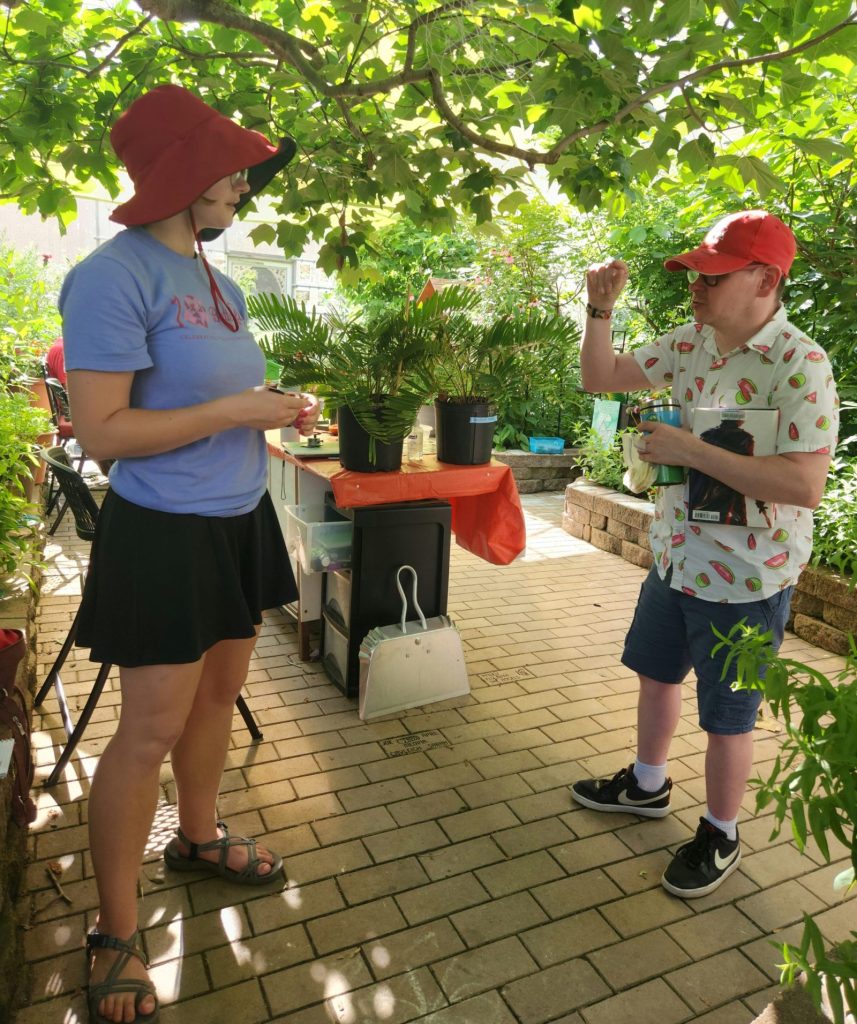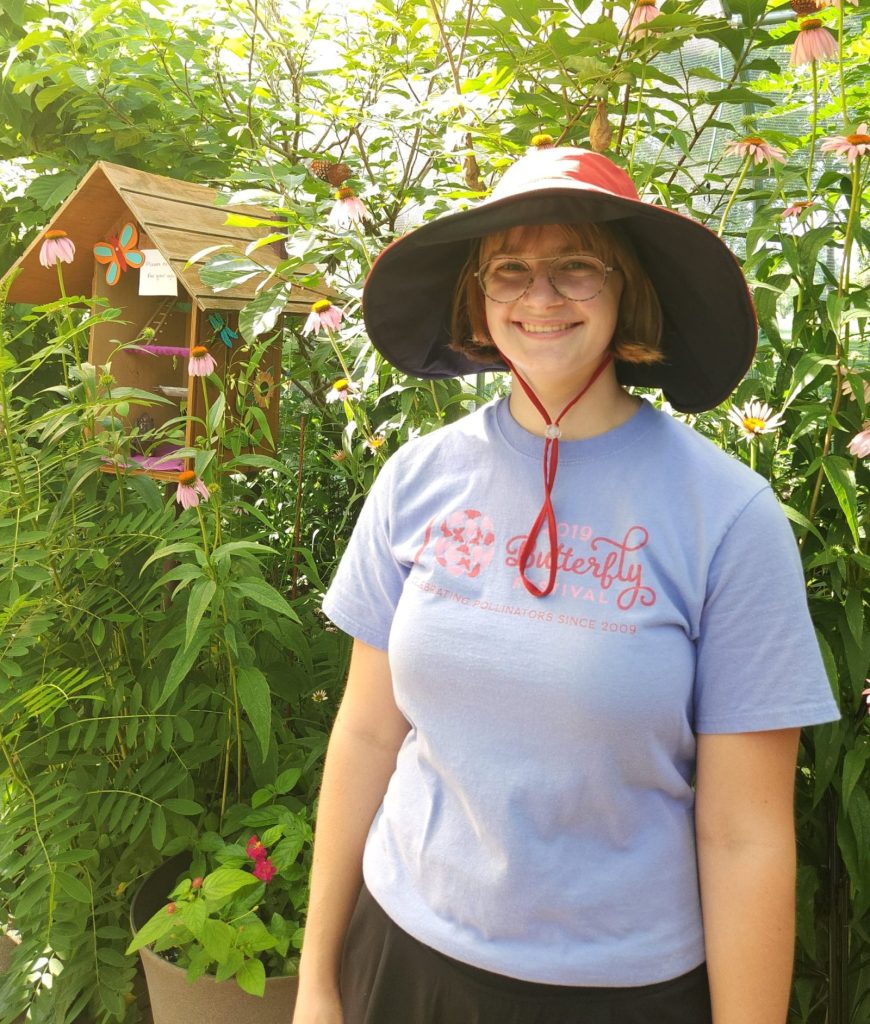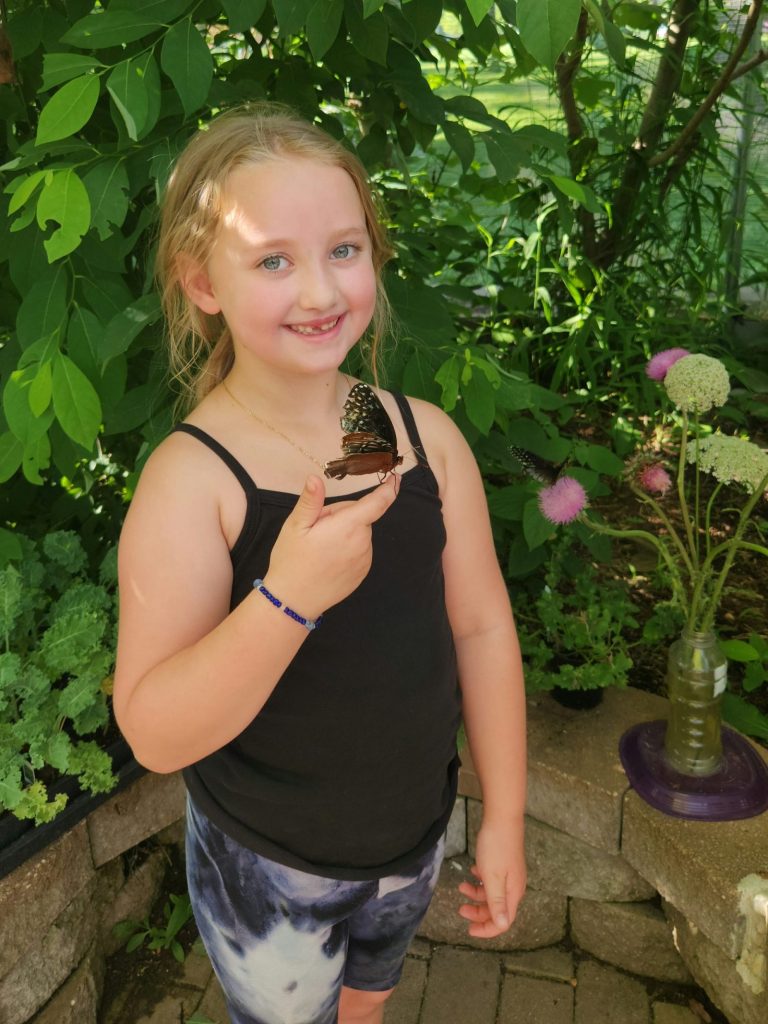Volunteering at the Roston Native Butterfly House was just a way for Anna Maria Snodderly to get out of the house — at first.
Four years ago, Snodderly’s family had moved from the Kansas City area to Rogersville. Accompanying her new neighbor, Linda Hall, to the retired elementary school teacher’s shifts as a volunteer docent, or guide, gave the then-14-year-old Snodderly something to do.
Soon, Snodderly had found her passion.
“We just started volunteering here, and honestly, it was so much fun,” she said Tuesday as she sat at the information table in the plant-filled hoop house, where colorful butterflies and moths flew from flower to flower while visitors streamed in to see them.
Now a plant science major at Missouri State University and paid intern at the butterfly house, the 18-year-old Snodderly knows much more about butterflies and moths than she used to. Like the other docents who will be on hand for Saturday’s Butterfly Festival, she’s eager to share the knowledge she has gained about the winged creatures.
While butterflies will take center stage at the 14th annual festival, held from 9 a.m.-3 p.m, at the Springfield Botanical Gardens at Nathanael Greene/Close Memorial Park, conservation education will be the focus.

Starting at the Friends of the Garden tent, kids can pick up a “butterfly passport” book. With the book, they can visit other tents to collect stickers from at least a dozen organizations, including Dickerson Park Zoo, Missouri Master Naturalists, Missouri Prairie Foundation, Springfield Conservation Nature Center and Wonders of Wildlife.
After visiting 12 stations, they can exchange their passports for a prize.
“It’s basically like a scavenger hunt,” said Friends of the Garden Executive Director Heather Parker. “That way, it gets them out to visit some of our other conservation groups, all these different groups that are really making an impact on our community.”
Butterfly festival is outreach effort and fundraiser
At the Peace Through People Pavilion, the Springfield-Greene County Library District will host storytimes. There will also be performances by Springfield Ballet, Princesses of the 417 and a family dance party by Jen Keet to add to the fun.

Visitors can also enjoy free tours of the MIzumoto Japanese Stroll Garden and the Gray/Campbell Farmstead — and there will be food vendors, Parker said.
The festival is not just an educational outreach program for Friends of the Garden and the Springfield-Greene County Park Board. It’s also a fundraiser for the butterfly house, which needs $14,000 to $15,000 a year to operate, Parker said.
Besides two summer interns’ salaries, donations and proceeds from T-shirt sales pay for supplies ranging from compost and host plants to bricks and office supplies, she said.
Over the course of last year, nearly 40,000 people from 49 states and 42 countries visited the butterfly house. Parker said she expects a strong turnout at the festival.
“It is our No. 1 attraction at the botanical gardens,” Parker said, adding that the butterfly house itself is the only free native butterfly house in Missouri.
Envisioning a refuge for native butterflies
About the size of a large greenhouse, the Roston Native Butterfly House was built in 2009. The year before, Dr. Bill Roston had begun to research the benefits of having a native butterfly house in Close Memorial Park. Parker had just begun to serve on the Friends of the Garden board.
Growing more than 900 varieties of hostas at his Christian County home near Honey Branch Cave, the Forsyth physician was known for his passion for plants.
Parker said Roston was also “brilliant in his visions for the gardens” then getting started at the park, established in 2001.
“He helped with many of the original gardens and worked with a team of men and women to really kick off the botanical gardens,” she said.
Volunteer butterfly house curators Chris and Debra Barnhart were part of that team.
As biology professor at Missouri State University, Chris Barnhart met Roston when he visited the university to give a presentation on underwater fish photography — another one of his passions.
The two became friends right away, Barnhart said, and soon he and Debra were raising caterpillars at their home for the park’s future butterfly house.
“I was best suited for raising butterflies because it was something I’d done as a hobby since I was a kid,” Chris Barnhart said.
Debra Barnhart remembers the first festival, held the year before the botanical center was built in 2010. Pea gravel instead of bricks lined the floor of the butterfly house. It had wooden doors and there were no raised beds for plants then.
But that first festival was a success.
“It was pretty well-attended, and there seemed to be a focus on hats,” Debra Barnhart recalled. “People came with all kinds of hats and all kinds of butterfly paraphernalia on their hats.
“And little kids came with butterflies on their costumes, and it was really fun.”
School of butterflies
Since Roston’s death in 2019, the Barnharts have continued to raise most of the butterfly house’s caterpillars, including luna moth caterpillars, Debra Barnhart said.
Chris Barnhart added that the population varies from week to week, depending on the season, but there are usually 15-25 different native species of butterflies and moths inside the house.
There, visitors can observe the stages of the butterflies and moths’ life cycles, from caterpillar to chrysalis to adult. Visiting the house is a “deep dive” into learning about how the rest of the ecosystem depends on that life cycle, Parker said.
“There are some of our songbird populations that eat thousands and thousands of caterpillars, so without having those native plants for the butterflies, you wouldn’t have those caterpillars for the birds,” she said.
Chris Barnhart agreed.
“The most important message in the butterfly house is that butterflies and everything else depends on native plants,” he said. “The butterfly house is really a plant house.”
Through hands-on activities like a caterpillar petting zoo for kids, festival-goers can develop a “deeper understanding of how it’s all connected,” Parker said.
Volunteers guide visitors
For their part, some 60 volunteer docents get the chance to share what they’ve learned.
“It gives us the opportunity to do a lot of one-on-one education as people come through the butterfly house as well as the kids and families that walk through our (caterpillar) petting zoo,” Debra Barnhart said.

What visitors learn sometimes surprises them, docents agreed. For example, few visitors realize caterpillars rely on specific host plants, said Hall, a docent since 2013.
“And really, hardly anyone knows that when they first come in,” Hall said. “But it makes sense. That’s how nature makes sure there’s food for everyone. Not everyone likes the same thing.”
Few realize how short the adult lives of butterflies and moths can be.
“It surprises most people to learn they only live about one or two weeks in their butterfly stage,” Snodderly said.
Springfield resident Charlee Hancock said she has learned how to approach butterflies and moths — from the front, not the back — to get them to land on her hand.
“They fly around, and they’re really easy to get on my finger, and I know a lot about them,” the 7-year-old said Tuesday.
Like Charlee, a regular butterfly house visitor, festival-goers can begin to build their own knowledge of the pollinators.
“It can all start at the butterfly house, and that’s where you can get those conversations going, really, for people of all ages,” Parker said.
For more information about the festival and butterfly house, visit the Springfield-Greene County Park Board website.


